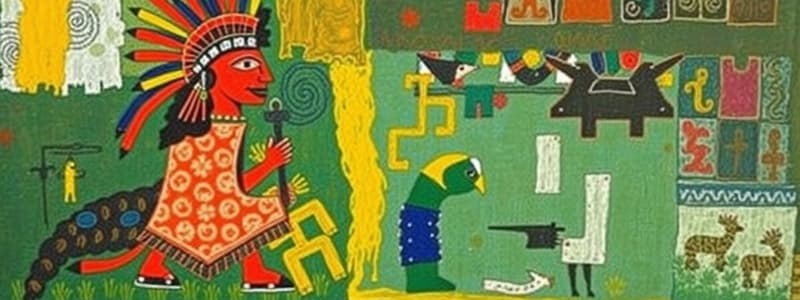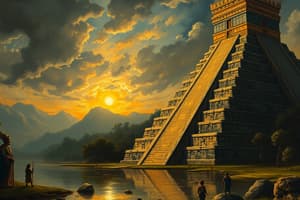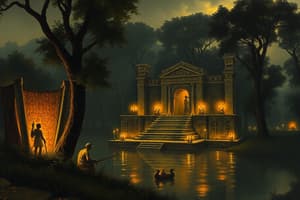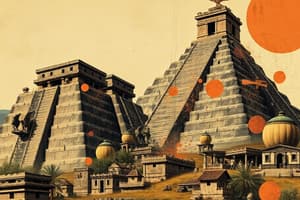Podcast
Questions and Answers
What was a significant aspect of Inca funerary rites in November?
What was a significant aspect of Inca funerary rites in November?
- People built elaborate tombs for the dead.
- The nobility would display their wealth through elaborate ceremonies.
- Families would attempt to feed the mummies of their ancestors. (correct)
- It was a month dedicated solely to ritual sacrifices.
What materials were primarily used for weaving Inca clothing?
What materials were primarily used for weaving Inca clothing?
- Synthetic fibers and linen
- Cotton and silk
- Leather and jute
- Wool from llamas, alpacas, and vicuñas (correct)
Which of the following describes the Inca calendar system?
Which of the following describes the Inca calendar system?
- It was purely lunar, based on the phases of the moon.
- It did not account for equinoxes and solstices.
- It combined both lunar and solar cycles in a lunisolar structure. (correct)
- It was solely solar, following the sun's cycle.
What was one of the uses of quipos in the Inca civilization?
What was one of the uses of quipos in the Inca civilization?
How did Inca artisans fit building stones together?
How did Inca artisans fit building stones together?
Which items were made from tumbaga in Inca culture?
Which items were made from tumbaga in Inca culture?
What basic unit of distance was most commonly used by the Inca?
What basic unit of distance was most commonly used by the Inca?
Which medical procedure was the Inca civilization known to perform successfully?
Which medical procedure was the Inca civilization known to perform successfully?
What type of weapon was commonly used by the Inca in battles?
What type of weapon was commonly used by the Inca in battles?
What was a distinctive feature of Inca jewelry?
What was a distinctive feature of Inca jewelry?
Flashcards are hidden until you start studying
Study Notes
Inca Funerary Rites
- November was considered the “month of carrying the dead,” a time when people would offer food to their ancestors' mummies.
Inca Textiles and Craftsmanship
- The finest Inca textiles were exclusively reserved for the Inca nobility and the emperor.
- Clothes were woven from wool obtained from dried llamas, alpacas, vicunas, and cotton.
- Inca artisans crafted objects from gold, silver, and combinations of these metals, including tumbaga (an alloy of gold and copper).
- Inca stonemasons demonstrated exceptional skill, perfectly fitting building stones without mortar, achieving such precision that even a razor blade couldn't be inserted between them.
Inca Calendar
- The Inca calendar was lunisolar, meaning it incorporated both lunar and solar cycles.
- Two separate calendars were maintained: one lunar and one solar.
- The lunar calendar had twelve months, falling 11 days short of a full 365-day solar year.
- The Inca calendar recognized equinoxes, solstices, and Venus cycles.
Inca Record Keeping
- The Inca used quipus as mnemonic devices for recording numerical data, history, and literature.
Inca Medicine
- The Inca practiced successful skull surgeries, drilling holes in the skull (trepanation) to relieve pressure from fluids buildup and inflammation caused by head injuries.
Inca Measurement System
- Inca physical measurements were based on human body parts: fingers, the distance between thumb and forefinger, palms, cubits, and wingspans.
- The most fundamental unit of distance was the thatkiy (pace).
Inca Weapons
- The Inca utilized a variety of weapons:
- Bronze or bone-tipped spears
- Two-handed wooden swords with serrated edges
- Clubs with stone and spiked metal heads
- Woolen slings and stones
- Stone or copper-headed battle-axes
- Bolas (stones tied to cords)
Studying That Suits You
Use AI to generate personalized quizzes and flashcards to suit your learning preferences.




